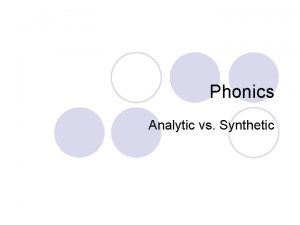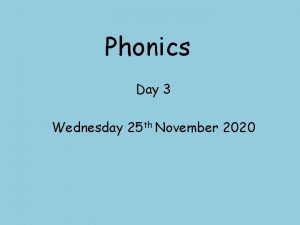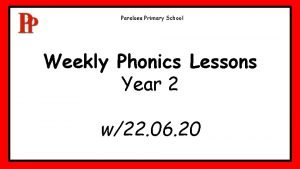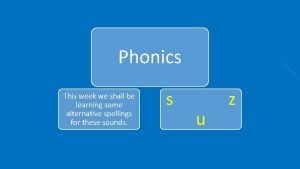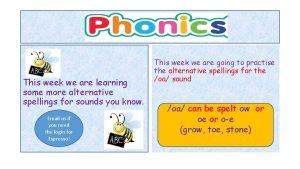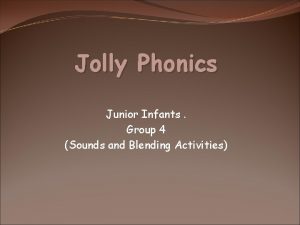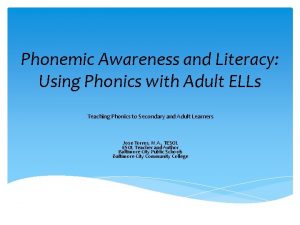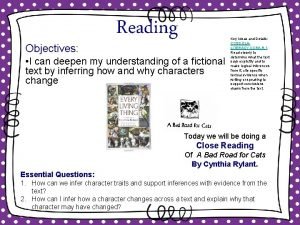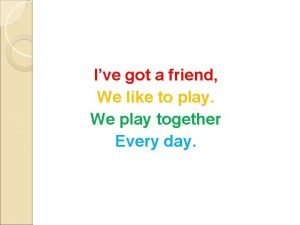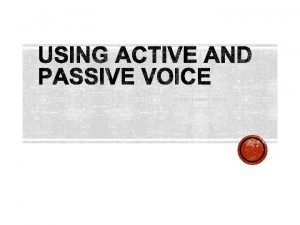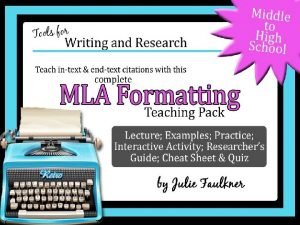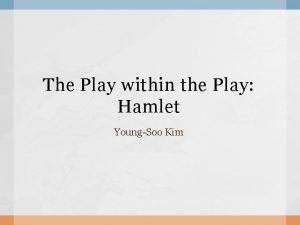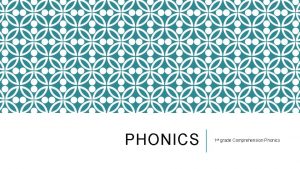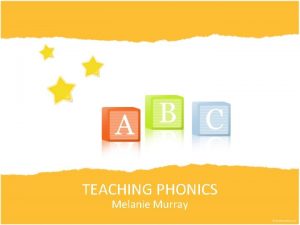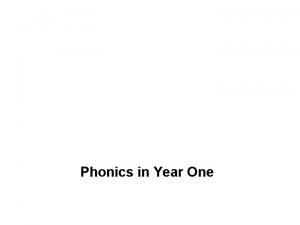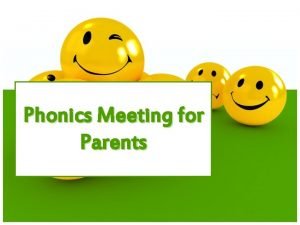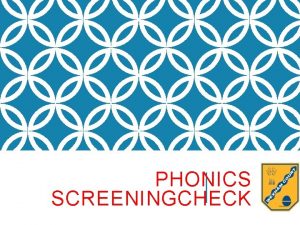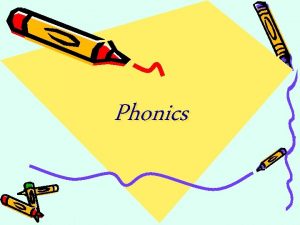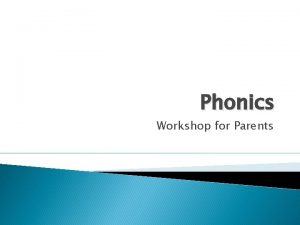PHONICS THROUGH PLAY Understanding phonics teaching in the











- Slides: 11

PHONICS THROUGH PLAY Understanding phonics teaching in the Early Years

What is phonics? Makes the link between sounds in spoken language and the letters used in written language. Uses a systematic approach- a clearly defined, logical sequence to introduce sounds (phonemes). Uses memory aids such as actions and pictures to reinforce understanding. Government guidance ‘Letters and Sounds’ specifies the expectations, describing in detail the phases of development. Children’s phonic development is formally assessed at the end of Year One.

Developing Speaking and Listening Skills Phase One phonics comprises of 7 elements: u Listening for environmental sounds (eg trains, birdsong, door shutting etc). u Making and differentiating between sounds made with percussion instruments. u Using clapping, stamping feet etc to make sound and create rhythm (body percussion). u Making and copying simple rhythms and identifying rhyming words. u Identifying and creating phrases that begin with the same sound (alliteration). u Using voices in different ways to create high/low/long/short sounds and to mimic familiar sounds eg duck quacking. u Oral blending and segmenting (see next slide)

Oral Blending and Segmenting § Blending is the ability to listen to different sounds (phonemes) and to run them together to make a word (eg identifying the sounds c-a-t individually and recognising that they blend to make the word cat). § Identifying the letters (graphemes) that are represented by these sounds is a skill necessary for reading. § Segmenting is the ability to separate words into their individual letter sounds (phonemes). § This skill is necessary for writing.

To avoid confusion. . . ! In Nursery we introduce the children to sounds (‘b’ as in boy) and do not worry about the alphabet letter names that adults use as labels (ABCD. . . as in the song). This is because it is the sound (phoneme) that the letter makes when spoken out loud that matters for early phonics. There are 25 basic sounds in English that are represented by a single alphabet letter (c and K make the same sound). We begin with these. There a total of 44 sounds to learn when we include those represented by 2 or more sounds such as chair or ship. Unfortunately not all words can be successfully decoded using phonics. In English a significant number of words need to be memorised – such as ‘the’, ’are’, ‘my’, ‘what’, ‘no’. Vowels make long and short sounds (ie short ‘u’ for umberella and long ‘u’ – pronounced ‘you’ - for unicorn). In Nursery, we begin by introducing the short sound.

Floppy’s Phonics This scheme is new to school and is produced by the team that publish the Oxford Reading Tree books that will be familiar to parents with older children. The scheme is based on the government’s Letters and Sounds programme. Floppy’s Phonics provides structured and engaging resources to support phonics teaching. It provides a range of materials to support children’s listening skills (phase 1) and then introduces each individual phoneme (sound) and grapheme (letter) with an action and song for the child to perform, as a memory aide.

Correct Pronunciation Attention must be paid to the correct pronunciation of phonemes. We need to use the ‘pure’ sound as this is will support children to learn to blend sounds successfully. For example we might be tempted to pronounced F as ‘fuh’ but, in fact, it doesn’t require the ‘uh’. It should be just ‘ffff’. This is true of many consonants eg – L, M, N, V, R. . . Vowels have short and long sounds as previously discussed. The long sounds can often be written in several different ways eg long E can be written as ‘e’ alone or ‘ee’ as in see, ‘ea’ as in tea, ‘ey’ as in key etc

Phonics in Nursery Daily activities and games to develop specific listening skills to support and embed phase 1 phonics eg create and copy rhythm, identify rhyme, blend and segment words In the Spring and Summer term, we have a Sound of the Week linked to our finding bag homework activity. The children are introduced to a new phoneme and its grapheme and we learn the action and song that accompanies it. At first the emphasis is on hearing the initial sounds in words, then the middle and end sounds in simple consonant-vowel-consonant (CVC) words. Opportunities to use phonic knowledge in writing in play situations eg in the role-play area (eg writing a shopping list or labelling an animal picture). Encouraging children to use their phonic knowledge to begin to recognise letters on print around the classroom environment and to decode simple CVC words.

Writing There are two types of ‘writing’ activity for very young children: 1 Writing name § From memory or using a name card § Emphasis on forming individual letters correctly (see letter formation sheet) § Holding pencil effectively (pincer grip). 2. Mark-making/Emergent writing § Differentiating between pictures and writing § Giving meaning to marks § Working from left to right § Breaking ‘writing’ into words § Beginning to form letter-type shapes § Beginning to sound out words and to use a letter/s (grapheme) to represent the appropriate sound (phoneme) in writing.

Supporting your child at home Talking about our ‘sound of the week’ Playing game such as I-spy (with sounds) Using ‘sound talk’ (can you find the c-a-t? ) to identify pictures or guess a hidden item Matching games – sounds to letter or pictures beginning with a specific sound Making up nonsense phrases to develop alliteration eg Happy Henry hopped through the hoop Making phrases from rhyming words – the fat cat sat on a mat wearing a. . Reading books and listening for rhyme/identifying the ‘sound of the week’ at the beginning of words Finding familiar letters in the environment –eg on road signs or in the supermarket) Encouraging your child to form letters using the correct formation when writing. Encouraging your child to develop their early writing skills by labelling pictures they have drawn etc.

More information and helpful videos about phonics teaching are available at: www. oxfordowl. co. uk/reading/l earn-to-read/phonics www. letters-and-sounds. com
 Analytic and synthetic phonics
Analytic and synthetic phonics Phonics play phase 5
Phonics play phase 5 Presetense
Presetense Phonics play obb and bob
Phonics play obb and bob Reading robot phonics play
Reading robot phonics play Teaching phonics to junior infants
Teaching phonics to junior infants Teaching phonics to adults
Teaching phonics to adults I believe i can deepen my understanding through
I believe i can deepen my understanding through I've got a friend we like to play we play together
I've got a friend we like to play we play together Louise made the chocolate cake active or passive
Louise made the chocolate cake active or passive Play by play
Play by play Hamlet
Hamlet
